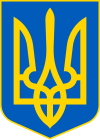This is an old revision of this page, as edited by Mack2 (talk | contribs) at 00:59, 21 July 2006 (You're mistaken, it's a strategic planning unit in office of Presidency. I know from personal observation.). The present address (URL) is a permanent link to this revision, which may differ significantly from the current revision.
Revision as of 00:59, 21 July 2006 by Mack2 (talk | contribs) (You're mistaken, it's a strategic planning unit in office of Presidency. I know from personal observation.)(diff) ← Previous revision | Latest revision (diff) | Newer revision → (diff)Ukraine is a democracy under a semi-presidential system with separate legislative, executive, and judicial branches. Ukraine presently is undergoing an extensive constitutional reform that would change the balance of power between the executive and legislative branches and their relationship to the President. A reform to local self-government has been suggested, but is yet to be formally approved.
| Politics of Ukraine |
|---|
 |
| Constitution |
| Presidency |
| Executive |
| Legislature |
| Judiciary |
Local government
|
| Elections |
|
Foreign relations
|
| See also |
|
|
Country summary info
- Country name
- conventional long and short form: Ukraine
- local long and short form: Україна
- former: Ukrainian Soviet Socialist Republic (for previous names see History of Ukraine)
- Country codes
- ISO 3166-1 Alpha-2: UA; ISO 3166-1 Alpha-3: UKR; ISO 3166-1 Numeric: 804; ITU: UP
- Dialing code: 380
- Government type
- Capital
- Kiev (also Kyiv, Template:Lang-uk)
- Administrative divisions
- 24 Oblasts (provinces), 1 Autonomous Republic, 2 Cities of central subdivision
- for details see Subdivisions of Ukraine
- Independence
- August 24, 1991, proclaimed by the parliament (from the Soviet Union)
- approved by referendum (popular vote) on December 1, 1991
- National holiday
- Independence Day, August 24, (1991)
- Constitution
- The Constitution of Ukraine was adopted 28 June 1996
- Legal system
- The Ukrainian legal system is based on the civil law and the judicial review of legislative acts.
- Suffrage
- 18 years of age; universal except legally deabled and under penal imprisonment following conviction. Suffrage rights automatically reestablished upon expiration of the penal term or an early release.
State symbols
Main article: ]

According to the Constitution, the state symbols of Ukraine are the State Flag of Ukraine, the State Coat of arms of Ukraine and the State Anthem of Ukraine.
- Flag
The State Flag of Ukraine is a banner of two equally-sized horizontal bands of blue and yellow.
- Coat of arms
The Great State Coat of arms of Ukraine will be established with the consideration of the Small Coat of Arms of Ukraine as its main element. The Small Coat of Arms of Ukraine ("the Trident") is based on the emblem of the Rurik Dynasty of the rulers of Kievan Rus'.
- Anthem
"Ukraine's glory has not perished" is the national anthem set to the music by M. Verbytskyi with the words by Pavlo Chubynskyi.
Head of state
Main article: President of UkraineAccording to the constitution the President of Ukraine is the head of state. The current president of Ukraine is Viktor Yushchenko (since January 23, 2005)
President is elected by popular vote for a five-year term. The last presidential elections were held in 2004 (See: Ukrainian presidential election, 2004).
Legislative branch
Main article: Verkhovna RadaVerkhovna Rada, a unicameral parliament (450 seats) amends the Constitution of Ukraine, drafts laws, ratifies international treaties, appoints a number of officials, and elects judges.
Elections were last held on March 31 2002. (See: Ukrainian parliamentary election, 2002). Next elections will be on March 26, 2006. (See Ukrainian parliamentary election, 2006).
Executive branch
Main article: Cabinet of Ministers of UkraineThe Head of the Cabinet, Prime Minister of Ukraine and most of his Cabinet are appointed by the Parliament. The current acting Prime Minister is Yuriy Yekhanurov, appointed on September 22, 2005. In early January of 2006 the Parliament retired the Cabinet, but asked to continue its functions until the new Cabinet is formed. The new Cabinet will be appointed by the next parliament convocation following the parliament elections on March 26, 2006.
Before the constitutional reform that was introduced as of January 1, 2006, the Prime Minister and the Cabinet were nominated by the President and approved by the Parliament. After the reform the Parliament has got the exclusive power in appointing the Prime Minister and most members of the Cabinet.
Judicial branch
Main article: Judicial system of Ukraine- Constitutional jurisdiction
- General jurisdiction
- The Supreme Court of Ukraine;
- High specialized courts: the High Arbitration Court of Ukraine (Template:Lang-ua), the High Administrative Court of Ukraine;
- Regional courts of appeal, military courts of appeal, specialized courts of appeal;
- Local district courts, military garrison courts.
The Constitution of Ukraine provides for trials by jury. This has not yet been implemented in practice. Moreover, some courts provided for by legislation as still in project, as is the case for, e.g., the Court of Appeals of Ukraine. The reform of the judicial branch is presently under way.
Other bodies
- Office of the Prosecutor General of Ukraine
- The Central Election Commission of Ukraine
- National Security and Defense Council (NSDC)
- NSDC was originally created in 1992 as the National Security Council, but significantly revamped and strengthened under President Kuchma. The NSDC staff is tasked with developing national security policy on domestic and international matters and advising the president.
- National Institute for Strategic Studies (NISS) was established by Presidential decree in 1992. It serves as a think tank devoted to the study of "national development strategy" (стратегія національного розвитку) for Ukraine, including economic, cultural, and foreign policies.